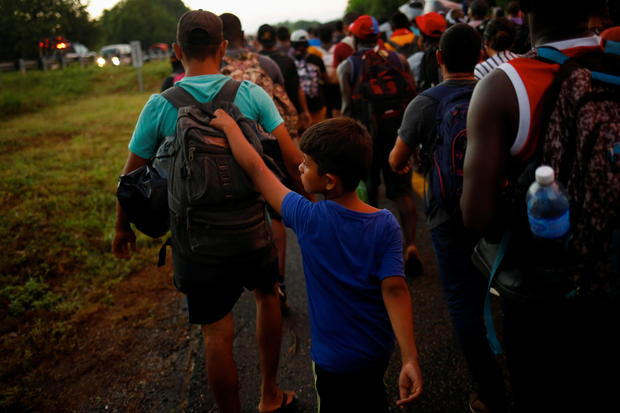The number of migrants taken into U.S. custody along the southern border increased in November after a three-month downward trend, driven largely by an uptick in illegal crossings by adults traveling without children, according to government figures released Friday. After reaching levels not seen in two decades over the summer, border apprehensions decreased consecutively in August, September and October. But last month, officials along the U.S.-Mexico border stopped unauthorized migrants over 173,000 times, a 5% increase from October. The jump in border apprehensions was also fueled by a record number of arrivals from Nicaragua and Venezuela, which virtually tied Guatemala as the second-largest source of migrants in November, surpassing Honduras and El Salvador. The majority of those taken in custody were single adults, who were stopped over 114,000 times last month. Two-thirds of them were quickly expelled to Mexico or their home country under an emergency coronavirus-era restriction known as Title 42, the statistics indicate. Title 42, which the Trump administration instituted in March 2020, permits border agents to expel migrants without allowing them to request asylum. Despite criticism from advocates, the Biden administration has retained the policy, arguing it is needed to curb the spread of COVID-19. U.S. Customs and Border Protection recorded a slight jump in apprehensions of migrant families traveling with children last month. Nearly 45,000 parents and children traveling together entered U.S. border custody. Border authorities also encountered 14,000 unaccompanied children in November, a 9% increase from October. Unlike the Trump administration, the Biden administration has not used Title 42 to expel unaccompanied minors, most of whom are transferred to government shelters. While tens of thousands of families have been expelled under Title 42 this year, most have been processed under regular immigration procedures and permitted to seek asylum. The Biden administration has discontinued long-term detention of migrant families, a practice progressive advocates strongly oppose. In November, three out every four family members were processed under U.S. immigration laws, which typically means they are released with a notice to appear before an immigration judge who will determine whether they have a legal basis to remain in the country, Friday's statistics show. The share of migrant arrivals from Mexico, Guatemala, Honduras and El Salvador — which have sent the largest number of migrants to the U.S. border in recent years — represented 65% of all apprehensions last month, down from 71% in October. Apprehensions of migrants from Mexico, Honduras and El Salvador all decreased in November, and arrests of Guatemalans rose only slightly. But those figures were offset by a sharp increase in arrivals of Venezuelan, Nicaraguan and Cuban migrants. More than 20,000 Venezuelan migrants were processed last month, an all-time high and a 50% increase from October. U.S. officials also encountered a record 13,600 Nicaraguans and 6,700 Cubans. Unlike migrants from Mexico and Central America's Northern Triangle, the U.S. generally can't use Title 42 to expel Venezuelans, Nicaraguans and Cubans to Mexico. But the administration has started subjecting them to another Trump-era border policy that requires migrants to wait for their U.S. hearings in Mexico. The U.S. has so far enrolled 176 asylum-seekers in the so-called Remain-in-Mexico program, which it resurrected earlier this month to comply with a court order, according to the International Organization for Migration. Most of the asylum-seekers returned to Mexico are Nicaraguans, and the rest hail from Venezuela, Cuba, Colombia and Ecuador. Apprehensions of migrants from Brazil, which reached a record 10,000 in September, decreased to 7,000 in November. Arrivals from Ecuador, which skyrocketed to 17,000 over the summer, dropped below 600. After more than 17,000 Haitians arrived in September, many of them near the small Texas town of Del Rio, U.S. border officials in November recorded 1,000 arrests of nationals from the destitute Caribbean country. The marked decrease in arrivals from Brazil and Ecuador comes after the Mexican government announced visa requirements for citizens from those countries, cutting off a channel migrants used to reach the U.S. border. Meanwhile, the low number of arrivals from Haiti follow a mass deportation campaign the U.S. launched in September to expel thousands of Haitian migrants. Mexican officials also increased migrant interdictions in recent months. Adam Isacson, a migration policy analyst, said the Biden administration may try to convince Mexico to impose visa requirements on additional countries like Venezuela, given the record number of migrants from that nation who were processed by the U.S. last month. "If Mexico is pressured into having visa requirements for people who arrive at airports from those countries, then that vector gets mostly shut down," said Isacson, who works at the Washington Office on Latin America. "That would also reduce the numbers, like it has with Ecuadoreans and Brazilians."

